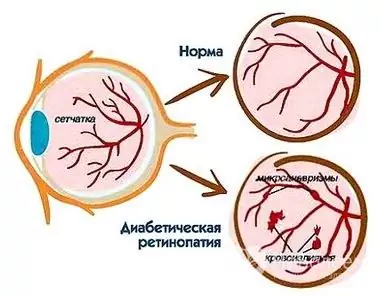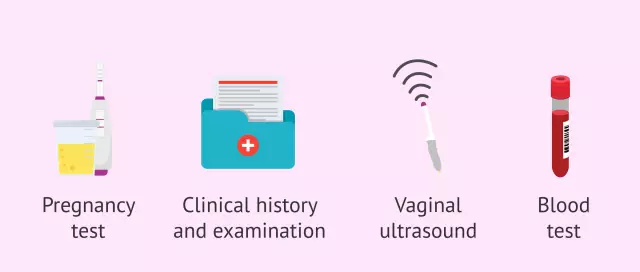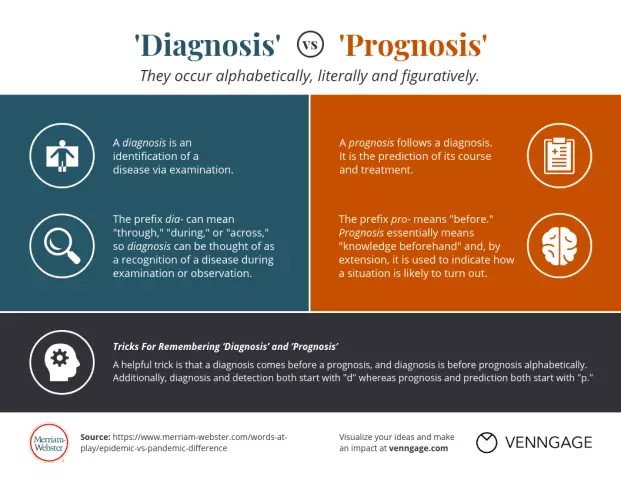- Author Rachel Wainwright [email protected].
- Public 2023-12-15 07:39.
- Last modified 2025-11-02 20:14.
Retinopathy
General characteristics of the disease

Retinopathy is a serious vascular disorder of the retina of the eye. Most often, the disease occurs in newborns and is called retinopathy of prematurity. In most cases, retinal blood supply disorders arise under the influence of high oxygen concentrations in the incubator. They are vital to ensure the breathing of a newborn with undeveloped lungs, but often lead to the development of retinopathy of prematurity.
The highest percentage of retinopathy of prematurity occurs, oddly enough, in countries with a high level of development of medicine. The neonatal technologies of these states are able to support the life of children with a 500-gram weight, born 3 months ahead of schedule and earlier. However, the imperfection of these technologies leads to vision pathologies, since the conditions of the incubator differ significantly from the natural environment for the development of the child - the female uterus.
In less developed countries, the problem of retinopathy of premature babies is not of such relevance for the simple reason that the overall survival rate of prematurely born children with low birth weight is much worse there.
Retinopathy symptoms
The symptoms of retinopathy of prematurity can be direct or indirect. The second group of symptoms of retinopathy includes a low weight of the child (less than 1.5 kg), an unstable condition after birth and the use of a cuvez in the first weeks of life.
Indirect symptoms of retinopathy of prematurity in the first two years of life are visual acuity disorders, strabismus, predominant use of one of the eyes.
The main symptom of retinopathy is the underdevelopment of the vessels of the retina, abnormal formations of connective tissue in the region of the retina, and then the lens. These pathologies can be diagnosed only with the help of special ophthalmic equipment.
Stages of retinopathy of prematurity
Depending on the severity of the disease, several stages of retinopathy of prematurity are distinguished.
Stage V retinopathy is characterized by complete retinal detachment caused by excessive tension of the eye tissues. For stage I retinopathy of prematurity, respectively, minimal vascular disorders of the retina are characteristic. Stage III retinopathy is considered a threshold. During it, the child is sent to the treatment of retinopathy using the laser coagulation technique.
Diabetic retinopathy

A more rare form of impaired blood supply to the retina in adult patients is retinopathy of diabetic etiology. In this case, the disease is a consequence of diabetes mellitus, both insulin-dependent and non-insulin dependent. Diabetic retinopathy is often accompanied by two other retinal vascular disorders of an atherosclerotic and hypertensive nature.
The symptoms of diabetic retinopathy are poorly expressed. The patient gradually develops edema of the macula (central part of the retina). Edema leads to multiple vitreous hemorrhages. Further symptoms of diabetic retinopathy depend on the form of the disease.
For background or non-proliferative diabetic retinopathy, small vessels and long-term course of the disease are characteristic. It is often called stage I diabetic retinopathy.
Preproliferative form - II intermediate stage of diabetic retinopathy before the onset of the proliferative form of the disease. The symptoms of retinopathy at this stage are multiple large areas of blood supply disturbance and a significant decrease in the quality of vision.
Diagnosis of retinopathy
Routine examination for retinopathy of prematurity is carried out every 2 weeks one month after the birth of the baby. Examinations continue until the retinal vessels are fully formed.
In the presence of symptoms of retinopathy, the examination is carried out every week or once every 3 days. Diagnosis of the disease is carried out using an apparatus for indirect binocular ophthalmoscopy. Atropine is preliminarily instilled into the child's eyes to dilate the pupil. Additionally, in the diagnosis of retinopathy of prematurity, ultrasound examination of the eyes can also be used.
Routine ophthalmological examinations in patients with diabetes mellitus are carried out every 5 years.
Retinopathy treatment
In the treatment of retinopathy of prematurity, timely initiation of therapy is extremely important. At stage I of the disease, dynamic monitoring of the state of the retina is recommended. One of the auxiliary measures at this stage is the treatment of retinopathy with cryoretinopexy (freezing of the peripheral areas of the retina).
When the III threshold stage of the disease is reached, laser treatment of retinopathy is performed - cauterization of the retinal periphery with a laser. Scars form at the site of the burns. Vision is lost in this area of the retina, however, with the help of laser treatment of retinopathy, it is possible to preserve central vision and prevent retinal detachment.

In the diabetic form of retinal vascular disorders, retinopathy treatment is also predominantly laser. However, since pathologies of the retinal blood supply in this case are a complication of the underlying disease, control over the blood glucose level is more important in the treatment of diabetic retinopathy. Timely correction of blood composition is the best prevention of further progression of diabetic retinopathy.
In severe stages of the disease, it is possible to surgically treat retinopathy using the vitrectomy technique. Thanks to its use, blood clots are removed from the eye cavity and the vitreous body. Thus, access to the retina is facilitated. After the retina is reconstructed and attached with a laser, the vitreous humor of the eye is replaced with a special oil or gas.
This method of surgical treatment of retinopathy is highly effective, but has a high risk of complications in the form of increased intraocular pressure.
YouTube video related to the article:
The information is generalized and provided for informational purposes only. At the first sign of illness, see your doctor. Self-medication is hazardous to health!






